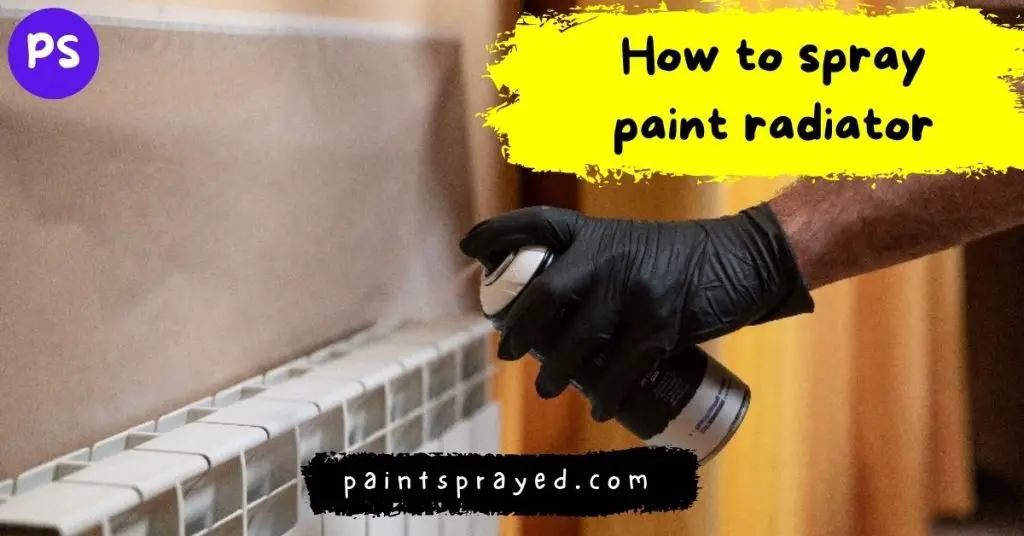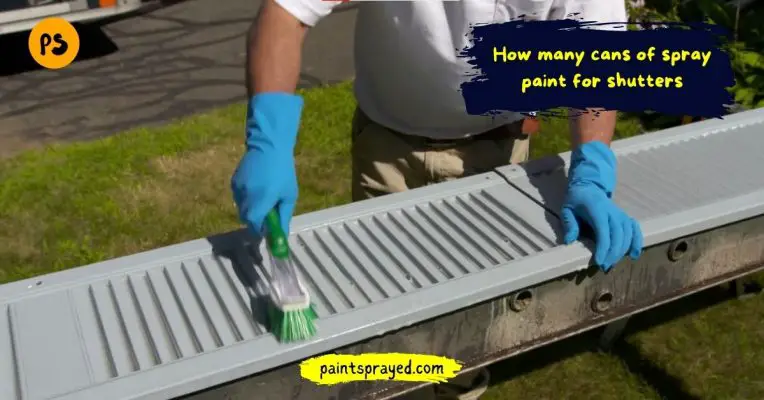Painting radiators have become a popular trend. The idea is that by painting your radiators, you can easily change their color without needing to replace them.
This is a great way to brighten up your home and make it feel a lot warmer. However, if you’re a bit wary of the idea, here is a quick guide on radiator paint.
This guide is more of a beginner guide than a general instruction. It assumes that you are well aware of how to remove the radiators from the wall and how to use spray paint.
If you are unsure then seek advice on the matter.
Your radiator is the unsung hero of your heating system. It draws heat through its pipes and then out into the room to keep your home warm.
But it isn’t much to look at, especially if it’s an old model. While radiators are usually considered more of a necessity than a focal part of your decor, you can dress up yours with a fresh color.
Let’s learn the complete method to spray paint radiators.
How to spray paint radiator
Tools you need to paint the radiator
- Radiator spray paint
- Sugar Soap to clean the radiator
- Paper or plastic sheets to protect walls and floors
- Mask for protection of fumes
- Gloves
- Glasses for eyes protection
- Sandpaper
- Cloths or rags
- Masking tape or newspaper
Prepare radiator
You should always have a cold radiator before painting it. That will ensure the paint not sticking to it and running away on you.
Most radiators are cold anyway, so the best thing is to turn it off at least 4-5 hours before you plan on spray-painting them.
You should also use paper or plastic underneath the radiator which is taped down in order not to get any paint on your floor or anywhere else.
Sand the surface of the radiator for the spray painting process
When sanding down a radiator that you are going to paint, always sand with the direction of the grain.
This will make the paint last longer and have a better finish. Sand the radiator with medium grit sandpaper, and then fine grit sandpaper.
If your radiator has a lot of rust, then you might need to sand it down further to get rid of it all.
Clean your radiator
Start by dusting the radiator entirely and then wipe it down with a damp cloth.
Dry it off completely to make sure there isn’t any residue, preferably using a soft cloth that you regularly use for cleaning purposes.
Start by dusting the radiator entirely and then wipe it down with a damp cloth.
Dry it off completely to make sure there isn’t any residue, preferably using a soft cloth that you regularly use for cleaning purposes.

Wash the radiator before spray painting radiator
Next, you should wash your radiators with sugar soap.
Sugar soap is an available cleaning formula that will be listed on the container as to the ratio needed for sugar soap water.
Wipe over your radiator completely with this mixture and let it dry out before usage.
Check everything before starting to spray radiator
When it comes to painting, preparation is everything. Before you even pick up a can of paint, remember to make sure that every room has been closed off completely.
Not only the rooms in which you will be applying the paint but also those leading to them directly – as well as all external windows.
These should have been open for at least two hours before you start work.
Start painting the radiator surface
Give your can a good shake for the next minute. Leaving around 20-25 cm between the can and the object you’re spraying, spray up & down to cover the surface.
Then give it a few left & right swipes to hit all corners depending on whether you’re holding you’re can vertically or horizontally respectively.
That’ll take care of most of the room. Remember to leave some time between coatings so as not to overdo it.
Though it can be tempting to just want to spray paint your whole radiator and be done in with it, if you don’t hold back.
You could end up with things looking pretty terrible (laminates actually tend to splatter as opposed to chipping).
Instead, take a few minutes for each object/area you wish to paint after thoroughly cleaning it of dust.
Then holding the can about 20 cm away from the surface itself (holding the can upright), gives three short bursts of the fine spray. This should cover the area completely and evenly.
What kind of paint do you use on a radiator?
For painting a radiator, it’s best to use heat-resistant paint specifically designed for use on radiators or other metal surfaces that will be exposed to high temperatures.
Some common types of heat-resistant paint include silicone-based paints, epoxy-based paints, and alkyd-based paints.
It’s important to follow the manufacturer’s instructions and to use the paint in a well-ventilated area to ensure proper curing and drying.
How do you spray paint a car radiator?
Spraying a car radiator with paint is a relatively simple process, but it does require some preparation and attention to detail to achieve a smooth and even finish.
Here are the general steps for spray painting a car radiator:
- Start by cleaning the radiator thoroughly with a degreaser and a wire brush to remove any dirt, grime, or rust.
- Next, sand down the surface of the radiator with fine-grit sandpaper to create a smooth surface for the paint to adhere to.
- mask off any areas around the radiator that you don’t want to paint, such as hoses, connections, and the surrounding engine compartment.
- Apply a coat of metal primer specifically designed for use on radiators or other metal surfaces. Allow the primer to dry completely before applying the paint.
- Apply the paint using a high-quality spray paint specifically designed for use on metal surfaces. Hold the spray can approximately 8-10 inches away from the surface and use a back-and-forth motion to apply the paint in thin, even coats. Allow each coat to dry completely before applying additional coats.
- Once the paint is dry, remove the masking tape and inspect the radiator for any missed spots or drips. Touch up any areas as necessary.
- Allow the radiator to dry completely before reinstalling it in the vehicle.
It’s important to follow the manufacturer’s instructions for the specific paint, primer, and metal surface you are working on.
Also make sure to work in a well-ventilated area and use appropriate personal protective equipment (PPE) when handling spray paint.
Do I need to prime a radiator before painting?
Yes, it is generally recommended to prime a radiator before painting it.
Primer helps to create a smooth, even surface for the paint to adhere to, and it also helps to prevent rust and corrosion.
Additionally, a primer can provide an extra layer of protection against heat and abrasion.
When priming a radiator, use a metal primer specifically designed for use on radiators or other metal surfaces.
This type of primer will create a strong bond between the metal and the paint, and it will also help to prevent rust and corrosion.
Make sure to follow the manufacturer’s instructions for the specific primer you are using, and allow the primer to dry completely before applying the paint.
It’s also important to note that if the radiator surface is rusty or corroded, it is important to remove it first before applying any primer or paint.
This can be done using a wire brush and sandpaper, or a chemical rust remover.
How do I prepare a radiator for painting?
Preparing a radiator for painting is an important step in achieving a smooth and even finish. Here are the general steps for preparing a radiator for painting:
- Start by removing the radiator from the vehicle, if possible. This will make it easier to paint and will also prevent any overspray from getting on other parts of the vehicle.
- Clean the radiator thoroughly with a degreaser to remove any dirt, grime, or oil that may be on the surface. Use a wire brush to scrub away any rust or corrosion. Make sure to clean all the nooks and crannies of the radiator.
- Sand down the surface of the radiator with fine-grit sandpaper. This will help to create a smooth surface for the paint to adhere to. Be sure to sand down all the nooks and crannies.
- Mask off any areas around the radiator that you don’t want to paint, such as hoses, connections, and the surrounding engine compartment.
- Clean the surface of the radiator with a clean rag and a solution of water and vinegar to remove any sanding dust or debris that may be on the surface.
- Allow the radiator to dry completely before applying primer or paint.
- If the radiator surface is rusty or corroded, it is important to remove it first before applying any primer or paint. This can be done using a wire brush and sandpaper, or a chemical rust remover.
It’s important to work in a well-ventilated area and use appropriate personal protective equipment (PPE) when handling degreaser, sandpaper, and wire brush.
Make sure to follow the manufacturer’s instructions for any chemical rust remover you may use.
FAQ’s of How to spray paint radiator
Summary of How to spray paint radiator
We hope you’ve enjoyed learning how to spray paint radiators. This is a really easy bedroom DIY project that can make a real difference to the look of your decor.
I hope you’ve found this step-by-step guide useful and that you’ll be able to quickly and easily use the steps we’ve given to make your job easier!
If you have any questions about spray painting radiators or any other parts of the home, please don’t hesitate to get in touch with us anytime in the comments section.

Matthew Edward is a professional painter who loves to paint and wants to share useful tips and tricks which he had learned in many years of experience in painting. He also used many products that can be used for painting he has tried and tested each and every product to give an unbias opinion about it in his review. This blog is very useful for those newbies who want to learn painting without making mistakes.






